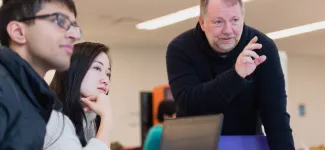As a lecturer in the Vantage College Academic English Program (AEP), Neil Leveridge discusses the power of visualization and virtual reality in teaching ESL students Chemistry.
I have been working at Vantage College for almost four years. I started in the summer before the first cohort of students arrived. I first heard about the Vantage program in the spring of 2014, when I was teaching at a university in Taiwan and a co-worker approached me about a job in Canada that he said I was perfectly suited for. After reading the advertisement and the aims of the Vantage program, I became increasingly interested. I had completed my Ph.D. in an additional language, so I understood first-hand the obstacles that arise for international students operating in a language other than their first language. I saw the Vantage program as a promising way for students to overcome many of those obstacles while facilitating the completion of their academic goals.
Can you summarise your approach to teaching Academic English at Vantage?When I begin planning instructional approaches, I really try to place myself in my students’ shoes. I first provide background information on the topic being covered that the students are most likely familiar with. I try to provide multiple means of presentation, allowing for recognition learning. Once recognition is achieved, I am able to provide a strategy for learning that is suited to the group of students in the class. This is the point at which students are able to express their ideas and become engaged in the learning process. Then, by providing examples of how the current lesson is linked to the students’ academic pathway, motivation for learning is not only generated but sustained throughout the lesson.
One example of this process is the recent pilot Virtual Reality Chemistry lessons I created in tandem with the Vantage College Chemistry instructor Kayli Johnson, with the incredible support from Vantage College’s Curriculum Manager, Brian Wilson.
What motivated your approach?I found that students were having a difficult time describing and explaining basic Chemistry theories in English. On further exploration, I found that while reading the Chemistry textbook, I had a difficult time visualizing the concepts of how molecules are shaped and how the substructures of the molecules were positioned. This difficulty stemmed from the textbook’s presentation mode, as these three-dimensional structures were presented in only two dimensions with segmented lines indicating directions or positions. This single mode of representation further confounded my understanding of why these structures were positioned in a particular way. As such, I was not able to fully understand the structural positioning that takes place when molecules are combined; one of the basic tenants of chemistry, also known as the Valence Shell Theory. I believed that if students were presented with alternative means of molecular representation, they may be able to better understand the underlying concepts and in turn be better prepared to describe and explain such theories in English.
Did any outcomes surprise you?For this project, we conducted a written pretest-posttest along with delayed in-class clicker questions based on the chemistry concepts. From the pretest/posttest, it was determined that those exposed to the VR experience were able to produce better, more accurate written descriptions and explanations of the chemistry concept. In addition, a multiple choice clicker question was given to all chemistry students and it was found that students who had participated in the VR experience scored an average of 1.5x the average score of those in the non-VR learning component.
What challenges have you encountered while using this technology to teach?When presenting students with new technology, one must consider that the technology itself may have an effect on learning. This effect is often referred to as the Novelty Effect. This effect presented itself during the VR experience. Many students had not previously used VR and did not realize how powerful and immersive the technology can become. We had to remind students that they could take off the VR visor at any time during the experience if they were feeling overwhelmed.
What are your next steps?As this Virtual Reality Chemistry/English Lesson was an initial attempt, we plan on creating a better, more accessible VR experience for the students. The initial attempt indicated that using VR as a way to better understand how molecules work in a 3D realm (rather than 2D), students were better able to describe and explain the concept in English as the basic tenants of the concept were made more concrete through the students’ navigation through the creation process. While in the small groups, students negotiated meaning and created strategies to accomplish the VR tasks. This will allow for more salient learning goals.
In what ways may your approach benefit the greater UBC community?From the initial offering of this lesson, I have been approached by other instructors on how we can collaborate to create more effective and efficient learning environments for science students using virtual reality.
What defines Vantage for you?For me, Vantage College is best defined by the mandate under which it was established, “...to be a living laboratory: a catalyst for pedagogical innovations, curricular design, and multidisciplinary collaborations.” Living up to this mandate, Vantage College instructors are redefining the boundaries of cross-curriculum collaboration, creating instruction that is more effective, efficient, and inclusive. Instruction that coordinated in this way provides learners with multiple means of representation, expression, and engagement. In other words, students are presented with various approaches to the acquisition of knowledge and alternative methods of demonstrating gained knowledge. Together, these provide innovative ways for students to be engaged, in turn enhancing motivation to learn.
For more information on Neil's teaching career, visit blogs.ubc.ca/neilleveridge/
